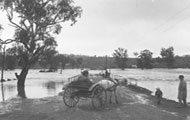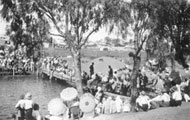Water in Canowindra
Canowindra sits on a flood plain of the Belubula River, which has proved a blessing and a hazard, depending on the season. The area was home to nomadic Wiradjuri people who travelled along the river before European pastoralists settled there.
When gold was discovered in the late 19th century, stamper batteries along the river crushed and washed quartz to extract the precious metal. When the gold mines closed, displaced miners turned to working on the lucerne that flourished in the deep alluvial soil of the river flats.
Mixed farming, notably sheep and wheat, also flourished, with windmills pumping water for stock from creeks, wells, dams and bores. Farmers later installed irrigation systems to pump water from the Belubula and Lachlan Rivers. Today large catchment dams and bores provide water for the developing viticulture industry.
The Belubula River has often been difficult to cross at Canowindra because of the wide flood plain. The solution has been a bridge over the river and another over the flood course. The two-lane John Grant Bridge was completed in 1997 and is the third at this site.
In 1928, a town water supply was installed. Water was pumped from a well between the bridges by a windmill to a large concrete water tower on the hill near the public school, but it was so hard that many householders retained their water tanks for soft water.
A breakthrough came when Canowinda was connected to water from Lake Rowlands near Carcoar in the late 1940s. A large reservoir was built on Blue Jacket Hill, the site of the former gold mines. As part of Central Tablelands Water, Canowindra now has a town sewerage scheme and a reliable domestic water supply. Farmers can also connect to the pipeline for stock and domestic water. Recently sewerage water has been recycled to irrigate the town’s showground and sports fields.

